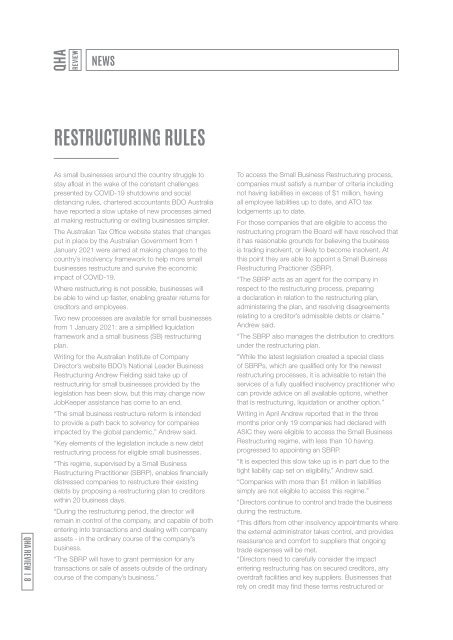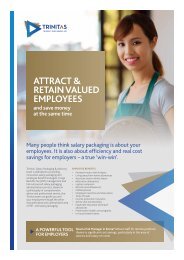QHA_August-2021-Digital
Create successful ePaper yourself
Turn your PDF publications into a flip-book with our unique Google optimized e-Paper software.
NEWS<br />
RESTRUCTURING RULES<br />
<strong>QHA</strong> REVIEW | 8<br />
As small businesses around the country struggle to<br />
stay afloat in the wake of the constant challenges<br />
presented by COVID-19 shutdowns and social<br />
distancing rules, chartered accountants BDO Australia<br />
have reported a slow uptake of new processes aimed<br />
at making restructuring or exiting businesses simpler.<br />
The Australian Tax Office website states that changes<br />
put in place by the Australian Government from 1<br />
January <strong>2021</strong> were aimed at making changes to the<br />
country’s insolvency framework to help more small<br />
businesses restructure and survive the economic<br />
impact of COVID-19.<br />
Where restructuring is not possible, businesses will<br />
be able to wind up faster, enabling greater returns for<br />
creditors and employees.<br />
Two new processes are available for small businesses<br />
from 1 January <strong>2021</strong>: are a simplified liquidation<br />
framework and a small business (SB) restructuring<br />
plan.<br />
Writing for the Australian Institute of Company<br />
Director’s website BDO’s National Leader Business<br />
Restructuring Andrew Fielding said take up of<br />
restructuring for small businesses provided by the<br />
legislation has been slow, but this may change now<br />
JobKeeper assistance has come to an end.<br />
“The small business restructure reform is intended<br />
to provide a path back to solvency for companies<br />
impacted by the global pandemic,” Andrew said.<br />
“Key elements of the legislation include a new debt<br />
restructuring process for eligible small businesses.<br />
“This regime, supervised by a Small Business<br />
Restructuring Practitioner (SBRP), enables financially<br />
distressed companies to restructure their existing<br />
debts by proposing a restructuring plan to creditors<br />
within 20 business days.<br />
“During the restructuring period, the director will<br />
remain in control of the company, and capable of both<br />
entering into transactions and dealing with company<br />
assets - in the ordinary course of the company’s<br />
business.<br />
“The SBRP will have to grant permission for any<br />
transactions or sale of assets outside of the ordinary<br />
course of the company’s business.”<br />
To access the Small Business Restructuring process,<br />
companies must satisfy a number of criteria including<br />
not having liabilities in excess of $1 million, having<br />
all employee liabilities up to date, and ATO tax<br />
lodgements up to date.<br />
For those companies that are eligible to access the<br />
restructuring program the Board will have resolved that<br />
it has reasonable grounds for believing the business<br />
is trading insolvent, or likely to become insolvent. At<br />
this point they are able to appoint a Small Business<br />
Restructuring Practioner (SBRP).<br />
“The SBRP acts as an agent for the company in<br />
respect to the restructuring process, preparing<br />
a declaration in relation to the restructuring plan,<br />
administering the plan, and resolving disagreements<br />
relating to a creditor’s admissible debts or claims.”<br />
Andrew said.<br />
“The SBRP also manages the distribution to creditors<br />
under the restructuring plan.<br />
“While the latest legislation created a special class<br />
of SBRPs, which are qualified only for the newest<br />
restructuring processes, it is advisable to retain the<br />
services of a fully qualified insolvency practitioner who<br />
can provide advice on all available options, whether<br />
that is restructuring, liquidation or another option.”<br />
Writing in April Andrew reported that in the three<br />
months prior only 19 companies had declared with<br />
ASIC they were eligible to access the Small Business<br />
Restructuring regime, with less than 10 having<br />
progressed to appointing an SBRP.<br />
“It is expected this slow take up is in part due to the<br />
tight liability cap set on eligibility,” Andrew said.<br />
“Companies with more than $1 million in liabilities<br />
simply are not eligible to access this regime.”<br />
“Directors continue to control and trade the business<br />
during the restructure.<br />
“This differs from other insolvency appointments where<br />
the external administrator takes control, and provides<br />
reassurance and comfort to suppliers that ongoing<br />
trade expenses will be met.<br />
“Directors need to carefully consider the impact<br />
entering restructuring has on secured creditors, any<br />
overdraft facilities and key suppliers. Businesses that<br />
rely on credit may find these terms restructured or

















